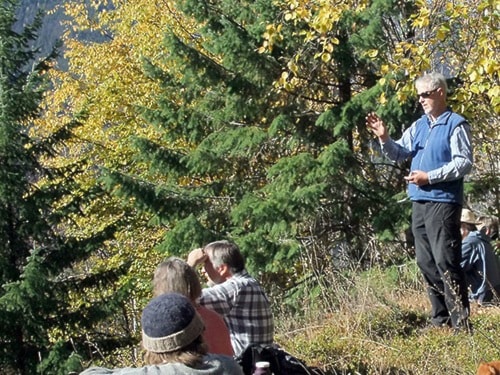“People told me I was crazy when I decided to settle in Upper Clearwater,” says Trevor Goward. “But I knew I’d get by”.
Today Goward makes a comfortable living through his business, Enlichened Consulting Ltd.
“People hire me partly for my specialist knowledge but also because I see things differently than other people do. I guess you could say I’m a contextual thinker, I tend to see the big picture”.
A leading international authority on lichens, Goward has written three books on the subject and more than 80 peer-reviewed papers. He has named two dozen species and has had several other species named in his honor. All this, and yet he has never taken a biology course, much less one on lichens. In fact, his only formal degree is a Bachelor of Arts.
Through his environmentalist activities and writing - for many years he wrote a newspaper column and later published the guide Nature Wells Gray - Goward has had a significant impact on the development of the park and surrounding area.
The local lichenologist was born 60 years ago in Vancouver. “I hated every minute we lived in Vancouver. When I was 10 years old my family moved to rural Kamloops. Finally I was free to roam the hills and forests as I’d dreamt of doing.”
Goward finished high school in 1970 and then took seven years to complete his undergraduate degree, first at Simon Fraser University, then at Universite de Sherbrooke in Quebec, and finally at Mount Allison in New Brunswick, where he majored in French and Latin.
In 1971 he got a summer job building trail with park superintendent Charlie Shook, who he describes as one of the most visionary superintendents Wells Gray Park has ever had.
His first stint as an environmentalist came in 1972, when with Roland Neave he guided bus tours in opposition to plans by B.C. Hydro to dam the Clearwater River.
In 1974 he returned to the park as park naturalist, a seasonal position he held pretty well continuously until 1986.
In 1976 he began to study the park’s lichens and became what he describes as a “lichen bum,” spending so much time at the UBC lichen herbarium that in 1989 he was invited to be its curator, a position he has held ever since.
In 1982 Goward got a summer job training foresters across B.C. about lichens, mosses and plants. He told his friends in Clearwater he’d be leaving but, after searching the entire province, found there was no place he liked better.
Goward acknowledges the influence of Bob and Hettie Miller. “They were different from other people,” said Goward. “They saw things most other people overlook. When some new duck landed on the pond, or warbler in the woods, they knew about it.”
The Millers also knew Wells Gray. Bob worked in the park for many years, and Hettie helped put it on the map for ornithology or the study of birds. They picked up many of their naturalist skills in the 1950s when Wells Gray Park was a government-funded center of research into moose, caribou, and other wildlife.
“Some of the classic studies on moose and mountain caribou were done here,” said Goward. “Wells Gray is where the first aerial wildlife surveys took place, as well as ground-breaking studies into their behaviour. The number of papers and reports written in those years is truly impressive.”
In 1984 Goward found his “dream property” in Upper Clearwater. A few years later he and then-partner Helen Knight built a home there, Edgewood Blue. Goward is now preparing to donate his home to The Land Conservancy of B.C. - this in support of a wildlife corridor connecting the two southern arms of Wells Gray. (He’ll stay on as caretaker).
In 1986 BC Parks brought out a master plan for Wells Gray. The plan encouraged scholarly research and mentioned having a research and education center.
Goward and Knight latched onto the proposal and ran with it. As founding members of the Friends of Wells Gray Park, they helped get that organization interested.
In 1990 Goward made a presentation to the board of the University College of the Cariboo (now Thompson Rivers University). The following year the university officially came onside, with support from Tom Dickinson, now the TRU dean of science.
Hazel Wadlegger, who was on the board of School District 26 (North Thompson) at the time, obtained the former Upper Clearwater schoolhouse for the center. In 1992 Goward and Knight donated 10 acres of land next to the schoolhouse.
TRU is presently constructing what will be called the Wells Gray TRU Wilderness Center. Opening is planned for the fall of 2013 and will be the grand finale of the Wells Gray World Heritage Year that Goward and others are promoting with TRU.
“Achieving UNESCO World Heritage status for Wells Gray Park and area would be a good thing for the local economy,” says Goward. “It’s only a matter of time before the values inherent in parks like Wells Gray become accepted by society at large - including our various resource industries.”
“I hope to dedicate the next 10 years of my life helping to build the conceptual platform we’ll need to launch a successful bid for World Heritage Site status.”
